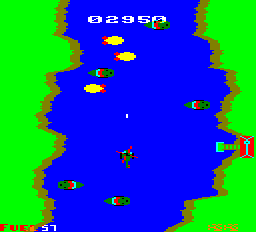
Assault on Port Stanley
(Amsoft, 1985)
The Falklands War of 1982 saw British forces retake the Falkland Islands after it was briefly occupied by Argentina, and this game is very loosely based on it. The game begins with you controlling a British warship and firing at enemy ships – although you can’t adjust the range of your gun. At any time, you can launch a helicopter, where you must dodge and shoot enemy planes. If you reach land before you run out of fuel, you must then fly your helicopter through a narrow channel and dodge even more enemies, while occasionally stopping at huts to collect troops and refuel. The gameplay is badly flawed, particularly in the first stage, where the best way to survive is to avoid confrontation with the enemy ships. The graphics are rather basic and there’s very little variety in the enemies you encounter.
![]() Watch YouTube videos of this game by:
GameHammer Classic Gaming,
Xyphoe.
Watch YouTube videos of this game by:
GameHammer Classic Gaming,
Xyphoe.
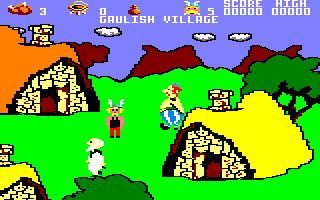
Recover the seven missing pieces of Getafix’s cauldron so he can brew his famous magic potion, or else the small village of indomitable Gauls will no longer be able to hold out against the Roman invaders. As always, it’s up to Asterix to save the day accompanied by his ever-ravenous friend Obelix. Make your way around the village, its forest, the surrounding fortified camps and even the Imperial capital itself whilst engaging in combat with nefarious legionaries, wild boars and even a Gladiator in the quest set before you. It’s a nice looking game, but it has no sound and is ultimately way too difficult as the fight sections are a bit of a gamble.
See also: Astérix Chez Rahàzade, Astérix et la Potion Magique.
![]() Watch a YouTube video of this game by:
jgonza.
Watch a YouTube video of this game by:
jgonza.
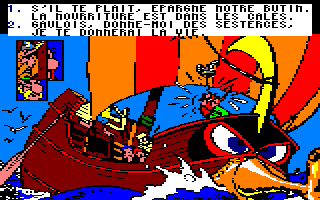
Astérix Chez Rahàzade
(Coktel Vision, 1987)
 Knowledge of French is required in order to play this game properly.
Knowledge of French is required in order to play this game properly.
Asterix and his colleagues are surprised when an Indian fakir, Kiçah, arrives at their village looking for help. The monsoon season has passed, and the Ganges valley, where the fakir comes from, has not seen any rain at all. Kiçah wants Asterix, Obelix and Cacofonix (or Assurancetourix as he is known to French readers) to travel to India before Princess Rahàzade is sacrificed to the gods. This is a graphic adventure where decisions are made based upon choices you make during conversations with the characters. Among the places to visit are Roman camps, Rome itself, a pirate ship, and ancient Greece. The graphics are spectacular, but the game can become slightly wearisome, and there seems to be no indication of how well you’re doing.
See also: Asterix and the Magic Cauldron, Astérix et la Potion Magique.
![]() Watch a YouTube video of this game by:
jgonza.
Watch a YouTube video of this game by:
jgonza.
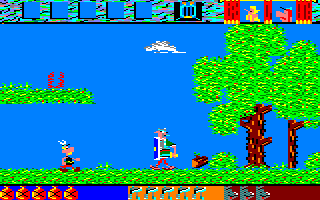
One of two Asterix games developed by Coktel Vision. Unlike the later game, Astérix Chez Rahàzade, which is a graphic adventure, this earlier release is more of a puzzle adventure game. A criticism levelled at CPC games is they often look better in screenshots in a magazine than when they’re running on an actual machine. That would be the case here. It’s a little blocky and a bit stiff in its movement. Having said that it’s also colourful and the characters are all recognisable. The game is very much in need of some nice music but it uses simple sound effects in gameplay. The ability to use three different characters (including Obelix) is welcome but it’s a finicky game to control and knowing what to do next can be hard to figure out.
See also: Astérix Chez Rahàzade, Asterix and the Magic Cauldron.
![]() Watch a YouTube video of this game by:
jgonza.
Watch a YouTube video of this game by:
jgonza.
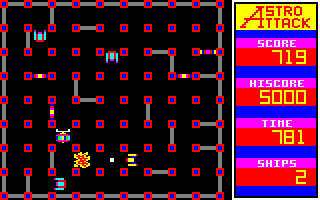
Astro Attack
(Amsoft, 1984)
The simplest games aren’t always the best as far as I’m concerned. This game sees you controlling a spaceship and flying it around a maze, firing at enemy spaceships and watching out for laser beams that pop up randomly to block your path. Once you destroy all the enemies, you’re faced with the same thing all over again. The graphics are extremely blocky, albeit colourful, but there isn’t much sound – and why should there be? Nonetheless, there’s only so much I can take of this game; it gets boring rather quickly for me.
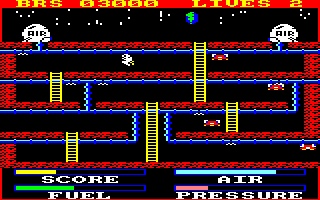
Astro Plumber
(Blue Ribbon, 1986)
You have been sent to a scientific research base beneath the Moon’s surface so that you can repair some leaking pipes. However, the underground caverns also contain many strange inhabitants that cannot be destroyed, and you will lose one of your three lives if you touch any of them. You have a jet-pack to help you avoid them, but it has a limited supply of fuel. Your supply of air is also limited, and you will need to return to the surface regularly to get some more air. This is a very simple platform game with basic graphics and very poor sound effects. The need to return to the surface regularly to refill your air supply, as well as the inability to destroy any of the inhabitants, makes this a frustrating game that you won’t want to play again after a few goes.
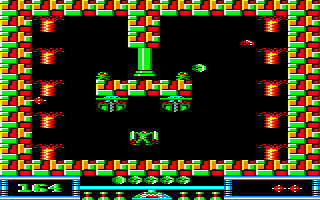
Astroball
(The Power House, 1988)
This is a simple and cheerful little game that starts off being addictive but becomes a bit frustrating. You control a ball which constantly moves left and right and bounces off the walls and anything else it comes into contact with – you can only move it up and down. The aim in each of the sixteen screens is to collect four objects within the time limit and avoid hurting the ball too much. The graphics are brilliant and the music on the title screen is also great, albeit a little bizarre for some tastes. However, most of the game is written in BASIC and the controls can often be unresponsive, and the ball sometimes has a mind of its own.
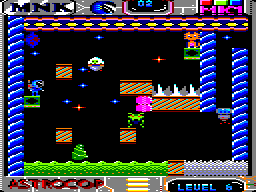
Astrocop
(Mananuk, 2022)
You joined the Space Police in the expectation that you would be fighting serious crime. Instead you’ve been assigned to the Cat Rescue Patrol to rescue cute kittens and give them the life they deserve – and that’s a noble cause too, right? As with Mananuk’s previous releases, this is a simple, no-frills platform game with 15 levels. Each level consists of two screens, and you have to rescue a kitten, collect a floppy disk, and then find a computer in order to progress to the next level. Even though you’re in the Space Police, there’s no shooting involved; you’re unarmed and you’ll have to dodge enemy aliens as best you can. The music is irritating, but the graphics are colourful, it’s fun to play and it isn’t overly difficult to complete the first few levels.
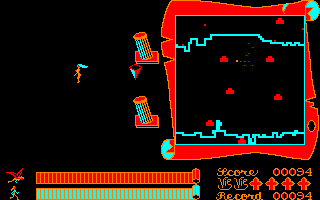
Atahualpa was the last ruler of the Incas before the Spanish came over to conquer Peru, and this game is set in that time period. The whole premise is slightly vague, but you control a young woman and must traverse the maze-like layout of the levels, avoiding the many enemies and collecting scattered items, all of which are shown on a handy map on the right of the screen. Things can get pretty hectic at times, but you are helped by the ability to sprout wings and fly above all the carnage for a limited time. The graphics are tiny and lacking in colour, there are too many bad guys after you, and the whole thing is just very vague and mysterious. There is a nice rendition of Ravel’s Boléro during the game, though.
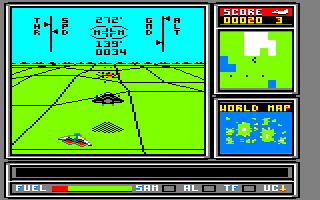
Pilot the Advanced Tactical Fighter across hostile territory in this flight simulator-cum-shoot-’em-up. Armed with a multitude of Amraam and Maverick missiles, as well as your gun cannons, you must engage enemy forces on land, sea and air. Fly over green pastures, deserts, mountains and oceans as you destroy the opposition’s fighters and installations. Viewed from a 3D perspective behind the plane, the ATF moves along nicely in the fast scrolling three-dimensional environment, and the surrounding information banks on your screen are a nice touch. While it has more of an arcade feel than most flight simulators, the loss of realism is compensated by good graphics, sound and gameplay.
